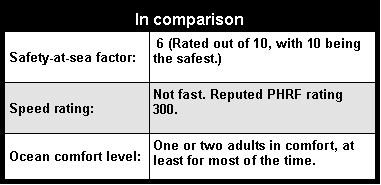"What's the Flicka got that makes otherwise rational deep sea sailors haul out their checkbooks?"
by John Vigor

You can't hold a sensible discussion about small seagoing sailboats without mentioning the Flicka 20. Who, you might ask, would willingly pay $60,000 to $70,000 to go to sea on a boat only 20 feet long on deck - about the length of three bathtubs?
The answer to that question is hundreds of people. At least 400 so far. So the next question is: Why? What's this snub-nosed midget got that makes otherwise rational deep sea sailors haul out their checkbooks and scribble their signatures in mad anticipation? The short answer is that she has charms that become more apparent and more beguiling the closer you get to her.
She is also, in many ways, a dream boat. She appeals to the adventurous spirit that erupts in all of us from time to time, even the armchair sailors. She's capable of crossing oceans in safety. She's our magic carpet, ready to waft us to the virgin white sands of desert islands where the palm trees rustle in the gentle trade winds, and warm blue waters murmur against the reef. And yet we can bring her home on a trailer and store her in the garage for winter, if we want. We don't actually have to cross an ocean in her. Knowing she can any time we want her to is good enough. That, and knowing our neighbors at the marina know she can.
There is also a good deal of reassurance in the fact that the designer of this boat, Bruce Bingham, lived and sailed on her for two years. He and Katy Burke cruised 6,000 miles in a Flicka called Sabrina, traveling down the eastern seaboard of the United States and crossing into the Bahamas. But, even before that, Sabrina took part in the 200-mile race around Long Island, New York, only four days after she'd been delivered. She finished fourth in the cruising class, according to the publicity people at Pacific Seacraft Corporation (PS), builders of the Flicka.
Flicka baby grand porthole in washboard
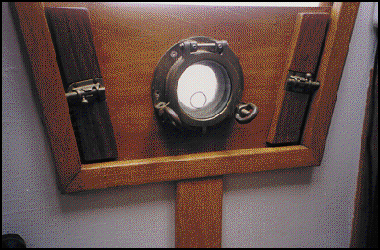
Bill and Janice Strop's 'Baby Grand' above and below, shows a love of beautiful ports and exquisite detail. Notice the beveled glass port and the hatch inset above. Bill says, "She's ash inside - no teak gloom," and adds, "She's just about as close to 'yar' as I can make her." She sails near Kansas City, Mo.
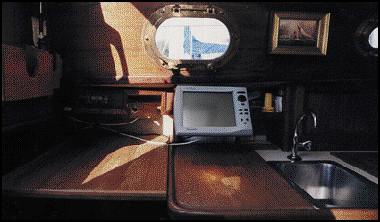
What PS neglects to say is how many entries there were in the cruising class. Four, maybe? No, we're being too cynical. We must give them the benefit of the doubt, and presume the annual race attracts dozens of cruisers. Which means the tiny 20-foot tot is interestingly light on her toes, too, but not exactly fast. According to the handicap ratings, she's 6 seconds a mile slower than the Cal 20, another 20-footer reviewed in the July issue of Good Old Boat. But if you're seriously concerned about 6 seconds a mile, it's obvious that you're not fit to own a Flicka yet. Your priorities are wrong. Please have your head examined and come back when you're better.
Flicka interior
The art of yacht design lies in intelligent compromise, and if you want to create a lot of space on a short waterline, you have to sacrifice looks or performance or a bit of both. Bingham took a small chance on performance and a bigger chance on looks by designing the Flicka with a hefty beam, tall topsides, and a high coach roof. She's tubby, and she's boxy, but somehow, although she has all the potential elements of a bathtub toy, she manages to avoid the sort of stomach-churning ugliness that repels you in mid-stride. Perhaps it's because her sterling character shines through her plain-Jane looks. Perhaps its because she's pug-ugly? Whatever it is, the word that most frequently comes to people's lips is "cute." And in this case, cute on deck translates into palatial accommodations down below, including headroom of 5 feet 11 inches and three full-sized berths. She's a heavy-displacement, Bermudian-rigged sloop or cutter (your choice) with a masthead rig and a headsail set from a short bowsprit. Her hull is solid fiberglass, and her fiberglass decks are cored with balsa, but there's solid plywood where deck hardware is attached. She is fitted out in the usual PS tradition, that is to say, with no expense spared regarding materials or workmanship.
Her bow, like that of the Dana 24, is distinctively plumb. In fact, it is even more than plumb - the very top bends aft slightly, the better to please the eye. Each Flicka, incidentally, has a very fancy curlicue molded in each side of the bow, joined by a cove line to a smaller one at the stern. She has a full keel that gathers depth increasingly as it sweeps toward the rudder, making her maximum draft just 3 feet 3 inches. Her 1,800 pounds of ballast is encapsulated well forward in the hull and forms about 30 percent of her total displacement of about 6,000 pounds.
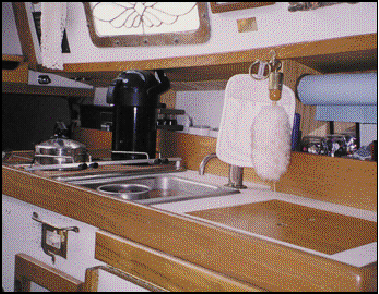
The Flicka is well endowed with beam - 8 feet (the same as a Cape Dory 25D) on a waterline of only 18 feet 2 inches - that slows her progress through the water but gives her spacious accommodations and greater initial stability. Her rudder is fixed to the flat transom and keel, a very seamanlike way of doing things. It's strong, simple, easy to get at, and easy to remove for repairs if necessary.
The decks are surrounded by raised bulwarks with a heavy teak caprail - the true sign of a bluewater voyager. The side decks are fairly narrow, allowing rather restricted access to the mast and foredeck. Luckily, it takes only a couple of steps to get anywhere on this boat.
The self-draining cockpit is small, but adequate for two, and is uncluttered by the mainsheet, whose traveler attaches to the pulpit railing aft. A watertight hatch in the cockpit sole affords excellent access to the optional inboard engine, and a high-capacity manual bilge pump is mounted handy to the helm.
The Flicka carries 20 gallons of fresh water in a tank under the quarterberth. You might want to take an extra supply in stowable jugs when you do cross that ocean. The head holding tank has a capacity of 8 gallons, and the diesel fuel tank, which lives up forward under the V-berth, quite divorced from the engine, also holds 8 gallons.
If you have an outboard engine, which is the choice of many Flicka owners, you can use the fuel tank for extra drinking water, of course. You'll also have a lot of extra space aft of the companionway steps.
Accommodations
As you step below on the Flicka, you gain the reward for her "cute" exterior. The interior is absolutely huge for a 20-footer, warm, and inviting. PS has used interior molds, bonded to the skin, but has covered much of the white fiberglass with honey-colored, hand-rubbed teak - enough to create an impression of classy workmanship and opulence, but not so much as to turn the interior dark and uninteresting.
The portlights are of solid bronze, and all six open to give as much through-ventilation as you're ever likely to need. Overhead, the white vinyl headliner is zipped in place for easy removal.
This is another boat with an open-plan interior; that is to say, there is no bulkhead separating the forepeak from the main cabin. A beefed-up deck beam takes the thrust of the deck-stepped mast, and apparently passes some of it down to the keel via an off-center compression post at the forward corner of the galley.
Flicka Esperanza
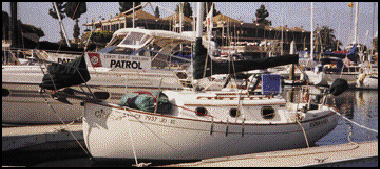
Phil and Trudy Cunningham's Esperanza, above, with the classy reading material, and below with the impressive dock partner, sails out of Dana Point, Calif. The happy result is the appearance of abundant space, starting up forward with the V-berth, whose size obviously benefits from the boat's generous beam. In what would normally be the main cabin, Bingham has provided a settee, a galley with a two-burner stove, a sink, and an icebox, and - wait for it - an enclosed head compartment and hanging locker to starboard of the companionway steps. To port, aft of the galley, is the third full-size berth, a quarterberth running under the cockpit. At sea, this will often be the only habitable berth, of course, but for two people working watch and watch about, that won't cause problems. There may be occasions, however, when both crewmembers are below in heavy weather, and in that case one of them is going to have to sleep on the cabin sole. But that is surely a small penalty to pay for owning such a "cute" boat.
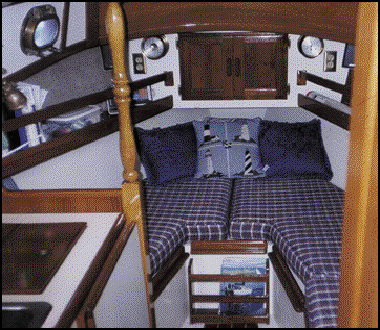
Flicka beam on
The rig
With spars and sails hardly bigger than a dinghy's, there's nothing complicated about this rig. You can turn the basic sloop into a cutter, if you are so disposed, but there really isn't much of an advantage to splitting up such a tiny rig, and there may even be a disadvantage in the extra windage created by the inner forestay and its associated halyard and sheets.
Both mast and boom are made of aluminum, painted with twin-pack polyurethane paint. The mast is stayed at the truck and has a single spreader, from whose roots spring fore and aft lower shrouds on each side. The backstay is made fast to the transom without any need for a boomkin. All the turnbuckles are of the forged bronze type, with open bodies.
The mainsail has an area of 106 square feet, and the working jib is a little bigger at 137 square feet. The mainsail has two rows of reef points built in, and by the time you've pulled down the second reef, there's hardly enough canvas left to blow your nose on. Very snug.
Flicka Corsair interior
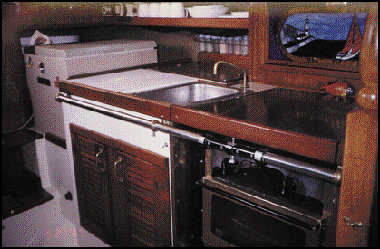
Not to be outdone, Corsair, formerly Owned by John Wolstenholme and Jan Allen, shows a stained-glass window in her galley.
Performance
Almost everything you say about the Flicka has to be qualified by the phrase "for her size." She's dry for her size. She's reasonably stiff for her size. She's quite fast for her size. But you have to remember that her size is small.
Her generous freeboard will certainly keep her decks dry when she's running or reaching, but when she's driving to windward in heavy weather, she will quickly start the spray flying aft to the cockpit. It's not her fault. She's only little. Similarly, her beam makes her stiff for a 20-footer, but she's not going to be able to fly all her working sail in 25 knots, as a Folkboat might. And while her initial stability is comparatively good, her ultimate stability cannot match that of a Contessa or a Nicholson 32.
It really doesn't help much to compare this boat with others. Her performance depends on where you take her and how you sail her. "Long passages of a 5-knot average and better are not uncommon," says the PS brochure. Well, you can't ask for much better than that. And if you count interior space and comfort as a measure of cruising performance, as you should, the Flicka suddenly emerges into a realm of her own. Besides, Flicka owners "tend to be independent and thoughtful" according to the observant staff at Pacific Seacraft. Just the kind of sailors who don't give a damn what anybody else thinks about their boats, good or bad.
Flicka Erika's cockpit
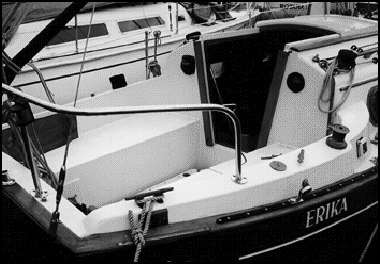
Above, Don Breazeal's Erika shows a roomy cockpit and her traditional underwater lines. Below, Erika plies North Pacific coastal waters.
Flicka Erika on a trailer
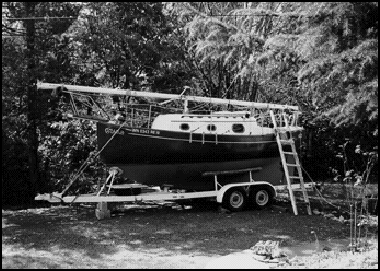
Known weaknesses
Smallness
Size is not the major factor in seaworthiness, and a small boat used with common sense and great caution can be reasonably safe at sea. Nevertheless, it would be foolhardy to attempt to cross an ocean in a boat as small as this without a solid knowledge of sailing and a fair amount of experience. That said, it must be acknowledged that many boats less seaworthy than the Flicka have crossed oceans and even sailed around the world. In the long run, it's the combination of boat and sailor that counts.
The difficulty of carrying a shore tender.
Even a rolled-up inflatable takes up a lot of room below on a boat this size. * Despite her wide beam, owners report that she's quite tender initially. She'll quickly heel over to about 15 degrees and then stubbornly dig right in.
The stove is not gimbaled
Flicka Kawabunga
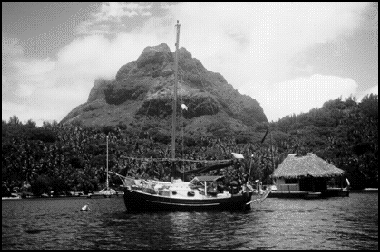
Charles and Margaret Dewell's Kawabunga at the Bora Bora Yacht Club in the South Pacific.
"On the way back I took a swing through the massive anchorage, counting 27 cruising boats of all designs, sizes, and flags . . . Kawabunga was by far the smallest, and by my eye, the most charming craft anchored in Taiohae Bay."
Charles Dewell, Kawabunga's South Seas Adventure
Flicka Valentin
Interior of Tim and April Kring's Flicka, Valentine.

Owner's opinion
One of the most famous owners of a Flicka is John Welch, who is retired and lives in Hawaii. He has sailed Betty Jane from California to Hawaii, and from Hawaii to Tahiti and back. He has also made a trip from Hawaii to Palmyra Island. During the outward trip to Palmyra, he experienced fine weather with steady northeasterly winds of 20 to 25 knots. Betty Jane wore her best working clothes with one reef in the main most of the way and flew along under perfect balance. Her best day's run was 123 miles, and she managed to average more than 100 miles a day over the whole passage. But the return trip to Hawaii was another matter altogether. "In one day it would go from becalmed to 45-knot squalls," Welch recalls, "absolutely the most adverse weather conditions possible." It made for a lot of work and many sail changes, but the Flicka never gave him cause for concern. "She really proved herself," he says.
Tom Messick also is the famous owner of a Flicka, but he's famous for a different reason. He and his teenage daughter, Mitzi, went aground in their boat, Tondelayo, during a lightning storm in Tampa Bay, Fla. After pounding on the sands of Egmont Key in fading light, Tondelayo was swept into the Gulf of Mexico and fetched up in the surf several hundred yards short of the ruins of an old fort. For hours the Flicka pounded in the surf on an incoming tide, lashed by steady rain driven by a 40-knot wind.
"Finally the lightning abated and we went on deck," Messick said. "We were able, in time, to turn her bow away from the beach. With the winch and the engine, we slowly began to make some progress, but we were paying an agonizing price as she would gain a foot, and then slam hard on the bottom again. In about an hour we finally came free."
Messick motored Tondelayo to an anchorage, checking the bilge all the way, but discovered it was bone-dry. "I could hardly believe my eyes," he said. At first light he checked for underwater damage and found nothing structural - just some scratch marks on the paint. He summed up his experience succinctly: "I have to conclude that our Flicka is one very tough lady.
1978 Flicka Yarns
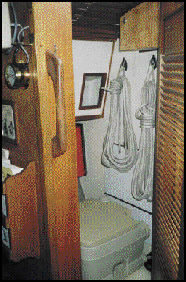
Above, Yarns, a 1978 Flicka, is owned by Karen Peterson, who sails her in the Pacific Northwest. Enclosed heads became standard by 1980.
Conclusion
The Flicka is high quality in a small package with a large price tag. But you have to remember that she offers the accommodations (if not the performance) of a boat 6 or 8 feet longer. For a cruising couple, that's snug, but ample.
Because she is a cult boat, and because she is strongly and sensibly constructed, the Flicka retains her value very well on the second-hand market. She ages well, and there is very little to go wrong. The price of a used Flicka will be substantially lower than that of a new boat, of course, but there are very few basement bargains unless you happen to come across one of the pre-1978 originals, built by an amateur from a finished hull or a kit. Flickas built by Pacific Seacraft are rugged, solid craft, with top-quality cabinetry, finish, and detailing. There isn't another production boat of her size in the U.S. that rivals her interior space and ocean-going capabilities. She's small enough to handle easily, but big enough to live in comfortably. For the price of a new Flicka, you could buy a used larger boat of another make, just as seaworthy and a whole lot faster and more comfortable. Hundreds of Flicka owners know that full well, but they're not tempted. This little spellbinder is all they've ever sought and all they'll ever need.
Flicka safety and speed ratings
